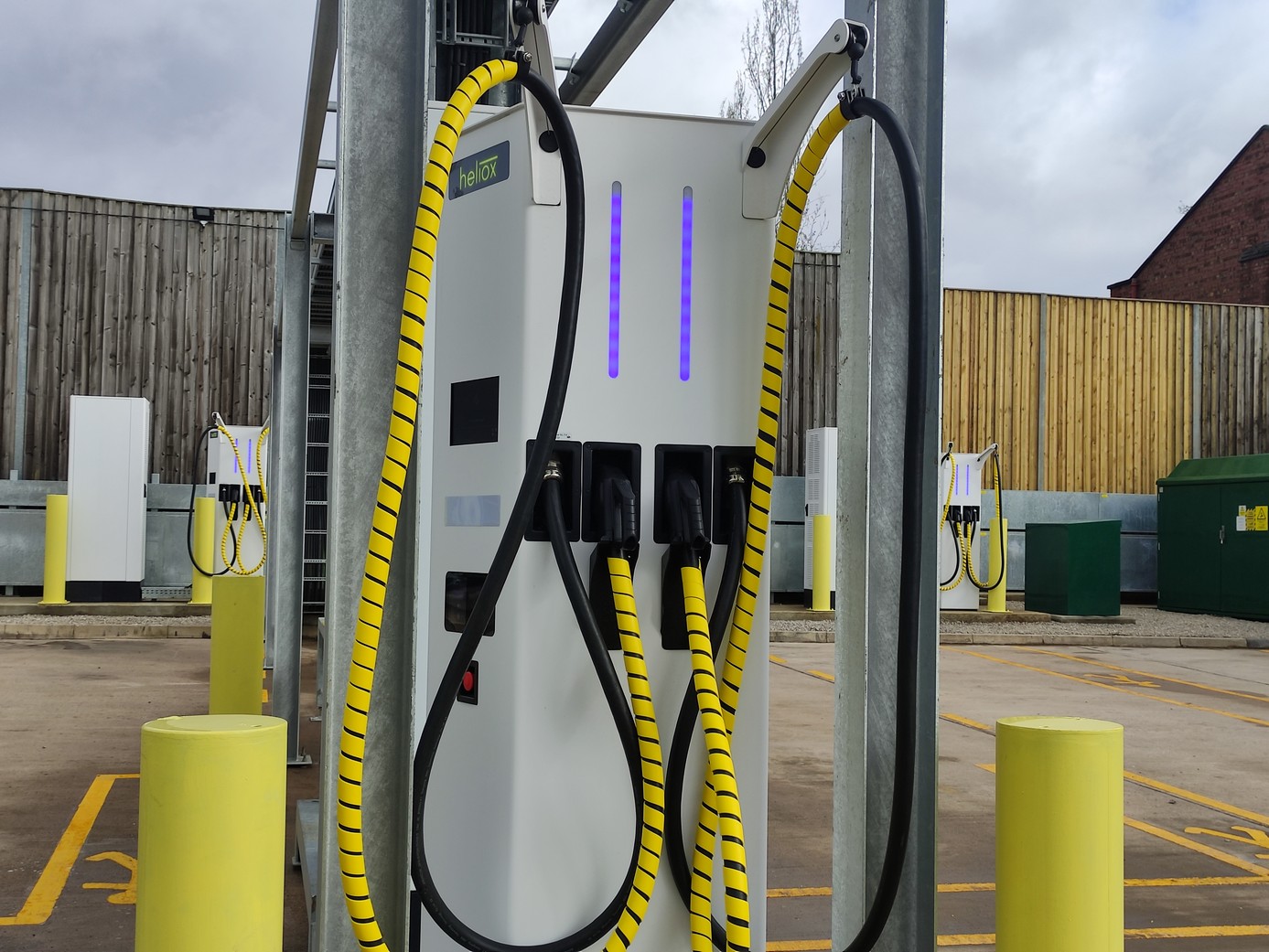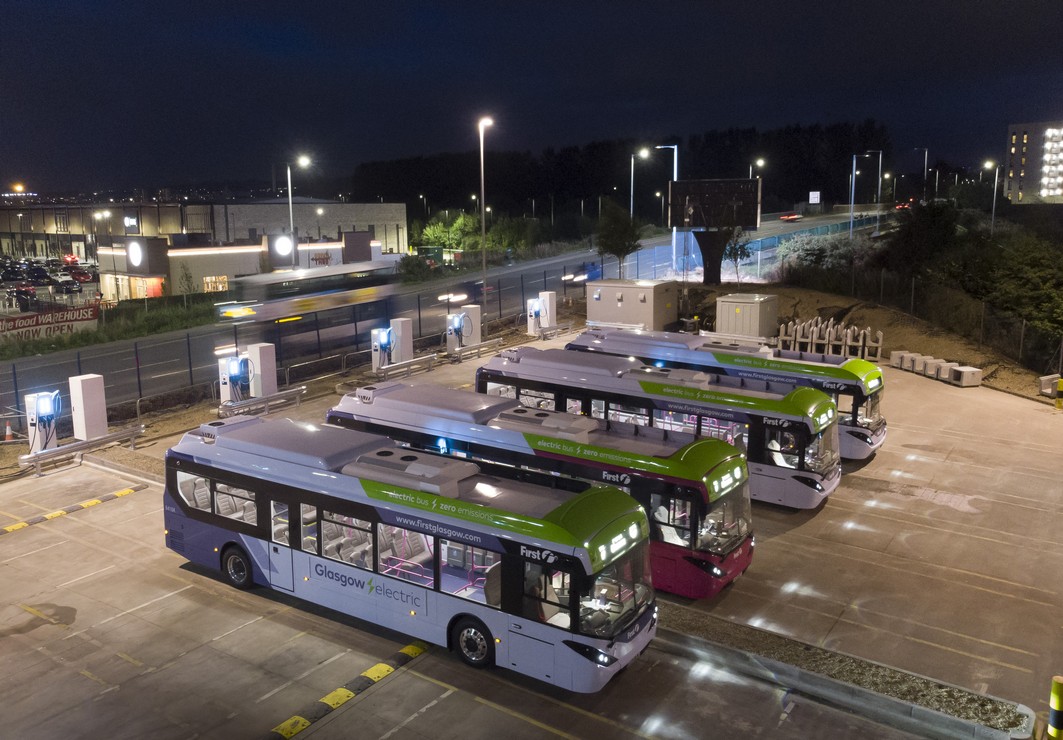It’s a year since First Bus completed the full implementation of its electric charging hub at its Caledonia depot in Glasgow. Lessons learned are influencing the next stages of EV infrastructure roll-out.
That’s the thing about charging cables. At 10 metres long, they require a great deal of effort to move them around.
It might come as a surprise to discover that cable length has been one of the most important lessons learned by the team at First Bus responsible for the implementation of electric vehicle (EV) charging infrastructure at depots across the country.
“When we started the project, we anticipated that having a longer charging cable would allow it to reach through to buses parallel parked,” explains David Seaton, Head of Construction with First Bus.
“The length also gave us flexibility in ensuring the dispenser would reach the charging socket on a bus regardless of vehicle design. Since then we’ve found we can get the same results with a cable that’s only 6.5 metres. We’ve also learnt more about space utilisation. Some 10% to 15% of parking capacity in a depot is lost when charging infrastructure is required. We’ve developed parking plans for a depot based on full EV implementation. That’s the starting point and we then drop back and adjust the plan to match what’s actually required.”

Always a fridge freezerDavid notes that other lessons have resulted in a new approach to some elements of the technical kit.
“Although things are fundamentally the same as they were when we started introducing EV charging infrastructure, we’re always looking at ways to improve what we do,” he says. “In Leicester we’ve brought in a new overhead gantry system. The charging dispensers can be controlled remotely meaning they can reach any bus. It makes for better space utilisation. At the moment, Leicester is our guineapig. We’re trying a few things out.”
David likens the familiar large charging unit that can be seen in almost every photo illustrating the charging process to a fridge freezer.
“It’s the size it is because that’s what’s needed to convert AC power to DC,” he says. “However, our preferred supplier of EV charging infrastructure, Heliox, has developed what it calls a Rapid Dispenser Cabinet (RDC). It’s a compact and versatile charging interface that can replace the fridge freezer ‘big box’ unit. We are now using the RDC where space is at a premium, including Leicester.”

Agnostic approach
David says that First is agnostic to all fuel types, whether that’s electric, hydrogen or whatever alternative fuels might come along.
“At the moment, EV is the route we’re following,” he says. “We have had 25 hydrogen double-deck buses operating in Aberdeen since April 2021 but our focus is on electric due to hydrogen availability.”
First’s EV journey began in 2014 in York where a project, fully funded by First, brought EVs into the city to operate on the Park and Ride network. AC charging was in place at what was one of the first EV projects in the country. York changed to DC charging in 2019.
In Leeds, in 2019, a different model was introduced as the city’s Hunslet Park depot moved towards introducing an EV fleet.
“That project was delivered through Zenobe,” says David. “The Dutch company funded the infrastructure and installation and is responsible for ensuring buses are charged daily and available for service. We trialled that model to explore the market. However, we have learned from Hunslet Park and prefer to follow the York model that has seen all our infrastructure fully-funded by part funding by government and part funding by First Bus. It gives us control over what we do. However, we continue to reassess the market in terms of suppliers and the products and services they can deliver. In the case of Heliox, not only does the company manufacture, supply and service the kit, it also offers a five-year guarantee on its products which is significantly better than others in the sector.”
The EV journey continues
In 2019 FirstGroup announced its intention to focus on its US operations and sell off the UK bus business. But by April 2021, following pressure from investors, it was the US business that was sold. This prompted a change in strategy and FirstGroup challenged the bus division to deliver a programme of decarbonisation.
In Scotland, under Andrew Jarvis, then Managing Director for First Bus Scotland, funding from Scottish Power’s Green Challenge Fund, and additional and significant funding from first and second rounds of the Scottish Government’s Scottish Ultra-Low Emission Bus Scheme (SULEBS) kick-started major EV activity in Glasgow. By August 2021, a growing fleet of electric buses were operating in the city from Caledonia depot. Many of those EVs were used to transport delegates attending COP26, the United Nations Climate Change Conference in the November. First had nailed its commitment to sustainable travel to a very clear mast! By the end of the conference there was an agreement that the UK would be diesel-free by 2030 and that no new diesel buses would be bought by First after December 2022. The latter has happened.

Futureproofing
“Our plan moving forward is to introduce EV charging infrastructure in one depot per business unit each year,” says David. “This all depends on funding of course. Of the 60 depots that we have, 20 will be straight forward to electrify. A further 20 are in what we might describe as the ‘really challenging’ category, and the other 20 are somewhere in the middle. The ‘too difficult’ description refers to a raft of issues from power supply to leases on the properties. But everything is moving quickly. What might be difficult today could become easier tomorrow. We are at a relatively early stage in EV roll-out so we are watching developments very closely.”
David explains that depots are being designed to be futureproof, to be able to deliver full EV capability. What that means in reality is ensuring there’s the power supply that will be needed.
“The hardest part of the process is discovering that the DNO (Distribution Network Operator) may not have realised how quickly the conversion to EV is happening,” he says. “On one site, when we started discussions, we were told we couldn’t have the power we needed until 2028! It all adds layers of complications to the process, but we’re building good relationships with DNOs.”

Net-zero depots
Looking at the roll-out of EV charging infrastructure across First Bus, Aberdeen is almost complete, and Leicester will be completed by the end of the year. Norwich (Roundtree Way) will be completed by the end of the financial year, as will an upgraded power supply in York. Bramley depot in Leeds has just started and Fareham (Hoeford) is on track to be fully EV next year. Developments for 2024/2025 depend, of course, on funding.
“The focus is on the fleet but it’s important to convert depots to net-zero too,” says David.

Sharing the infrastructure
Back at Caledonia and the depot is being used for proof of concept to see how EV chargers, laying unused during the day, can be used by other organisations. Since November 2022, parcels carrier DPD, along with Police Scotland, have been utilising the facility. First says this will be replicated at Glasgow Scotstoun, Aberdeen and Leicester. Might this be one route for coach tour operators to investigate as they consider how a future electric coach could be used on overnight tours and private hire?
In terms of opportunity charging, David is clear.
“The issue is ownership of the infrastructure,” he says. “Bus stations are the ideal location but operators don’t own them. At present the focus is firmly on depot charging.”
The lessons learned by First Bus have proved invaluable in giving the operator the confidence to move forward. But with the focus on the infrastructure and the vehicles, there’s another element that can be overlooked.
“My ambition with all of this is that, as a country, we need to do something,” says David. “By greening the fleet, we’re making it easier to allow passengers to make their own decisions on sustainable travel. Doing all this makes it easier for customers to travel more sustainably.”



























